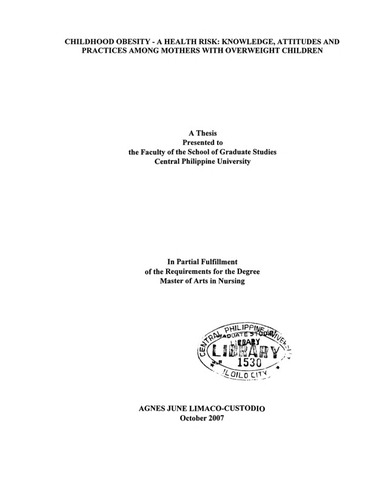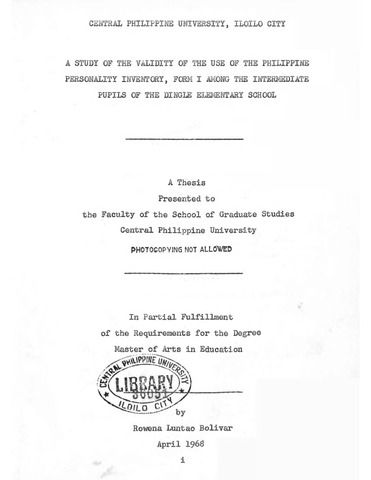Показать сокращенную информацию
Childhood obesity - a health risk: Knowledge, attitudes and practices among mothers with overweight children
| dc.contributor.adviser | Panerio, Douglas | |
| dc.contributor.author | Custodio, Agnes June L. | |
| dc.date.accessioned | 2021-02-22T05:36:59Z | |
| dc.date.available | 2021-02-22T05:36:59Z | |
| dc.date.issued | 2007 | |
| dc.identifier.citation | Custodio, A. J. L. (2007). Childhood obesity - a health risk: Knowledge, attitudes and practices among mothers with overweight children (Unpublished Master's thesis). Central Philippine University, Jaro, Iloilo City. | en_US |
| dc.identifier.uri | https://hdl.handle.net/20.500.12852/491 | |
| dc.description | Abstract only | en_US |
| dc.description.abstract | This study was conducted to determine the knowledge, attitudes and practices related to childhood obesity among mothers of overweight children in Filamer Christian College. Specifically, the study sought to determine the characteristics of the respondents according to age, educational attainment, monthly income, employed parent, weight status, and family history of obesity and diabetes. It also sought to determine their level of knowledge about childhood obesity, their attitude towards the condition and its management as well as their level of practices in its control and management. The study further attempted to determine possible relationships between the respondents’ characteristics with their knowledge, attitude and practices, and the relationship of these variables with each other. A one-shot survey design was utilized in this descriptive-correlational study. Total enumeration was done involving mothers of overweight children ages six to ten years old. A face to face interview was conducted guided by a questionnaire which has been duly validated and pre-tested. Written consent from the participants were secured prior to the conduct of the interview. Statistical tools of frequencies and means were utilized to interpret the descriptive data while Chi-square test, Gamma coefficient test of association and Pearson’s r were used to determine relationships and correlations of the variables. Major Findings The respondents were split between the two age groups, namely below thirty-five years old and thirty-five years old and above. All except one of the respondents had college degree. The majority of the respondents had a monthly income of more than 20,000 pesos, half of them come from families with only one parent employed while the other half belong to families wherein both father and mother are employed. Most of the mothers are within normal weight range, while a little above a tenth were overweight and obese. The majority of them had no family history of either obesity or diabetes. The majority of the respondents were aware of the health risks associated with childhood obesity however, only a few considered it to be a major health problem. Some mothers still attributed childhood overweight or obesity on the child’s appetite instead of the imbalance of proper diet and exercise. Only a few were aware that obesity may also lead to certain types of cancer and less than half of the respondents were unable to identify that their child is overweight. On the whole, the respondents’ level of knowledge about childhood obesity was average. The major sources of information about the condition were journals and magazines as well as family, relatives and friends, television and radio. The majority of the respondents had positive attitude towards children with obesity and towards its management. They considered obesity as an unhealthy condition that needs to be controlled and managed. They also believed in their important role in the management of the condition. However, only a third of the respondents said that they are not embarrassed when people notice their child’s overweight. The majority of the respondents had fair level of practices in the control and management of childhood obesity while nearly a fifth has poor level of practices. No relationship was found between the respondents’ level of knowledge about childhood obesity and their personal characteristics namely, age, monthly income, educational attainment, weight status, employed parent and family history of obesity and diabetes. The respondents’ characteristics were not also related to their attitude towards childhood obesity and its management. On the other hand, employment status of parents was found to be related to their level of practices. The findings reveal that respondents from families wherein both parents are employed had poor to fair levels of practices whereas respondents from families with only one parent employed had fair to good levels of practices. All the other characteristics were found to have no relationship to their level of practices in the control and management of childhood obesity. No relationship was also found between the respondents’ level of knowledge about and their attitude towards childhood obesity and its management. Regardless of the respondents’ level of knowledge about childhood obesity (be it high or average), their attitude towards the condition and its management was positive. Similarly, no correlation was found between the respondents’ level of knowledge about childhood obesity and their level of practices in the control and management of the condition. Regardless of the respondents’ level of knowledge about the condition their level of practices was fair. No correlation was also found between the respondents’ attitude towards childhood obesity and level of practices on its control and management. Their level of practices was generally fair regardless of their attitude towards the condition and its management. When the respondents’ attitude was controlled, a moderate correlation was found between their level of practices and level of knowledge. Respondents with positive attitude towards the condition and its management tend to apply their knowledge on their practices to control and manage the condition. Conclusions The study revealed that the mothers of obese children were highly educated and came from a middle to high income group strata. Half of them were employed along with their husband, while half were either the sole provider of their family or were not employed. On the basis of the findings of this study, it is reasonable to conclude that the mothers were knowledgeable about obesity in general. Such information were mostly derived from print materials (journals and magazines), from family, relatives and friends and from televisions. However, with regard to childhood obesity, mothers have misconceptions about the condition and tend to underestimate its risk on the child’s health. Despite the fact that most mothers in the study were highly educated and have a variety of access to information about childhood obesity and its risk, their level of knowledge about the condition is still average. Half of them were even unable to identify overweight in their own child. The fact that most of the mothers had positive attitude towards childhood obesity and its management, irrespective of their personal characteristics, is a good indication that they can manage childhood obesity well. The fact however that mother of overweight children had poor to fair practices in the control and management of the condition, indicate that they still need to learn how to manage the illness. Even if our knowledge and/or attitude are good, without proper practice the knowledge is useless. Work role is an important consideration in the practice of correct management of obesity. When classified according to level of knowledge about the condition, it was established that there is significantly more respondents with better practices in the control and management of the condition among those with higher level of knowledge. The findings showed that the mothers’ knowledge do influence their behaviors or practices. Lastly, mothers with positive attitude towards childhood obesity and its management tend to translate their knowledge about the condition into relevant practices to manage their child’s excess weight and avoid its grave complications. Recommendations Based on the conclusions stated above, the researcher favorably recommends the following actions: 1. Inasmuch as the mothers’ awareness about childhood obesity is not so extensive, government, school and health institutions should unite and continue to work on enhancing such knowledge by utilizing the information agencies that are mostly accessed by the mothers which include but not limited to journals and magazines, televisions, radio, lectures and seminars and other venues. 2. Mothers and other primary caregivers of children should be educated on proper implementation of dietary regimen which is suited for the child’s age. Part of this education will include emphasis on limitation of certain foods, not total elimination. Family involvement should also be emphasized inasmuch as the environmental influence has a strong effect on the child’s choices. 3. Many mothers have difficulty in identifying or “accepting” their child’s overweight condition. Such bias or misperception needs to be corrected before effective behavioral modifications will be implemented. A mother’s acceptance of the child’s overweight status and the need for help is the first step towards its effective management. A support group for these mothers could be organized with focus on ways to help them identify and accept the child’s overweight or obesity and the need for help. Focus should be placed on the emotional support of both the mother and the child, considering the psychosocial trauma brought by the condition. Health workers such as pediatricians and nurses, particularly those specializing in maternal and child health nursing have a big role on this program. 4. The concept of childhood obesity, which has long been a part of the nursing curriculum, should be given more emphasis in view of the impact of the condition on the child’s health. Nursing students should be taught how to assess children and identify overweight and obesity, and properly deliver health teachings to both the child and the family. 5. Considering the number of hours, the children spend in school everyday, school administrators can help by implementing control of the foods being served in the school canteen and cafeteria and ensure that lesser “junkfoods”, softdrinks, and fatty foods are in the menu and more nutritious snacks are made available to the children. To increase the children’s level of physical activity, daily morning exercise may be implemented and recess hours or break time may be utilized to organize games that involves running or such like physical activity. 6. Finally, the government should turn its focus on eliminating obesity in congruent with their task to overcome malnutrition. Either side of the scale remains a threat to the child’s health if taken for granted. | en_US |
| dc.format.extent | xvi, 83 leaves | en_US |
| dc.language.iso | en | en_US |
| dc.subject.ddc | GSL Theses 610.73072 L628 | en_US |
| dc.subject.lcsh | Obesity in children | en_US |
| dc.subject.lcsh | Obesity | en_US |
| dc.subject.lcsh | Mothers | en_US |
| dc.subject.lcsh | Children--Health and hygiene | en_US |
| dc.subject.lcsh | Children | en_US |
| dc.subject.lcsh | Overweight children | en_US |
| dc.subject.lcsh | Parents of overweight children | en_US |
| dc.subject.lcsh | Overweight persons | en_US |
| dc.subject.lcsh | Mothers--Attitudes | en_US |
| dc.subject.lcsh | Health behavior | en_US |
| dc.subject.mesh | Obesity | en_US |
| dc.subject.mesh | Overweight | en_US |
| dc.subject.mesh | Mothers | en_US |
| dc.title | Childhood obesity - a health risk: Knowledge, attitudes and practices among mothers with overweight children | en_US |
| dc.type | Thesis | en_US |
| dc.description.bibliographicalreferences | Includes bibliographical references | en_US |
| dc.contributor.chair | David, Fely P. | |
| dc.contributor.committeemember | Lamasan, Nelida L. | |
| dc.contributor.department | School of Graduate Studies | en_US |
| dc.description.degree | Master of Arts in Nursing | en_US |
| local.subject | Filamer Christian University (FCU) | en_US |





